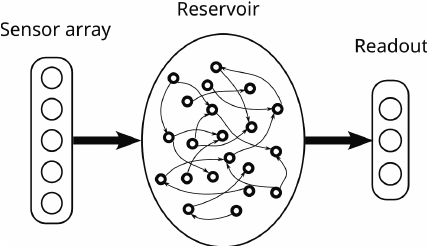

| Funding period: | Jan. 1, 2015 to Dec. 31, 2018 |
| Agency: | European Union |
| Funding scheme: | FET Open |
| Further details: | https://www.chalmers.se/en/projects/Pages/RECORD-IT.aspx |
We acknowledge funding by the European Union FET Open project "Reservoir Computing with Real-time Data for future IT" (RECORD-IT)
The aim of this proposal is to develop a biocompatible sensing device to detect and classify complex behavioural changes in ion concentrations on the biological scales at the cell level or higher. We are proposing an entirely novel concept to use reservoir computing for sensing purposes. A reservoir computer is a device with two key properties: the dynamics has to be able to map inputs into different regions of the configuration space, and it must exhibit fading memory (forgetting too distant past). The advantage of a reservoir computer is that the information processing is done automatically, and there is no need to train the device using special techniques, apart from using an easily trainable linear read-out layer. Technological implications of the concept are enormous since, in principle, any sensor network could be turned into a powerful information processing unit. The main challenge is to implement such behaviour experimentally and we will build a prototype. It will consist of components used for sensing (S), memory (M), and integration (I) to achieve reservoir computing properties: iono-organic memristors/transistors (S), coated Si nanowires (S), self-conjugated polymers (S), photocell arrays (S/I), biomimetic neural extracellular matrix (S/M/I), and the flow of lipids (I). The information about ion dynamics will be obtained by observing how the response of the device changes when the concentration of ions is altered. The device will be operated by (1) driving it with pre-defined patterns on the input pins (voltage/current), (2) monitoring internal state by recording voltage/current on the probing pins, (3) and analysing how the probing values change in time. The high sensitivity of the device will be achieved by ensuring a strong coupling between the environment (ionic solution) and the device. The key research challenges will be: accessing the feasibility of the idea to use reservoir computing for sensing complex environmental changes, identifying suitable integration strategies for the components, optimizing the sets of input/output pairs (response functions) and the device components for enhanced sensitivity.


| Funding period: | Jan. 1, 2015 to Dec. 31, 2018 |
| Agency: | European Union |
| Funding scheme: | FET Open |
| Further details: | https://www.chalmers.se/en/projects/Pages/RECORD-IT.aspx |
We acknowledge funding by the European Union FET Open project "Reservoir Computing with Real-time Data for future IT" (RECORD-IT)
The aim of this proposal is to develop a biocompatible sensing device to detect and classify complex behavioural changes in ion concentrations on the biological scales at the cell level or higher. We are proposing an entirely novel concept to use reservoir computing for sensing purposes. A reservoir computer is a device with two key properties: the dynamics has to be able to map inputs into different regions of the configuration space, and it must exhibit fading memory (forgetting too distant past). The advantage of a reservoir computer is that the information processing is done automatically, and there is no need to train the device using special techniques, apart from using an easily trainable linear read-out layer. Technological implications of the concept are enormous since, in principle, any sensor network could be turned into a powerful information processing unit. The main challenge is to implement such behaviour experimentally and we will build a prototype. It will consist of components used for sensing (S), memory (M), and integration (I) to achieve reservoir computing properties: iono-organic memristors/transistors (S), coated Si nanowires (S), self-conjugated polymers (S), photocell arrays (S/I), biomimetic neural extracellular matrix (S/M/I), and the flow of lipids (I). The information about ion dynamics will be obtained by observing how the response of the device changes when the concentration of ions is altered. The device will be operated by (1) driving it with pre-defined patterns on the input pins (voltage/current), (2) monitoring internal state by recording voltage/current on the probing pins, (3) and analysing how the probing values change in time. The high sensitivity of the device will be achieved by ensuring a strong coupling between the environment (ionic solution) and the device. The key research challenges will be: accessing the feasibility of the idea to use reservoir computing for sensing complex environmental changes, identifying suitable integration strategies for the components, optimizing the sets of input/output pairs (response functions) and the device components for enhanced sensitivity.